In March of 2022, Tad hosted an Ultimate Safaris/Kusini FAM showcasing some of Namibia’s best higlights. Here is his rather belated trip report. That is to say, when travel came back, it REALLY came back!
It was fantastic to see Birgit and Tristan after a longer than anticipated time and to reconnect with the Ultimate team and tour their awesome office.
As with all FAM trips and most Namibia safaris, our adventure kicked off in Windhoek. We stayed at Galton House, one of Ultimate Safaris’ properties. It’s a comfortable, well-located guesthouse in the suburbs with lovely common spaces including a refreshing pool. We enjoyed a great sundowner/gin tasting on our first evening, trying several types of local Namibian gins – a big thing in Southern Africa these days. Namibia has some surprisingly (for me) excellent gins (there were lots of options to try) and it was a fun way to kick off our trip and get to know our group a bit.
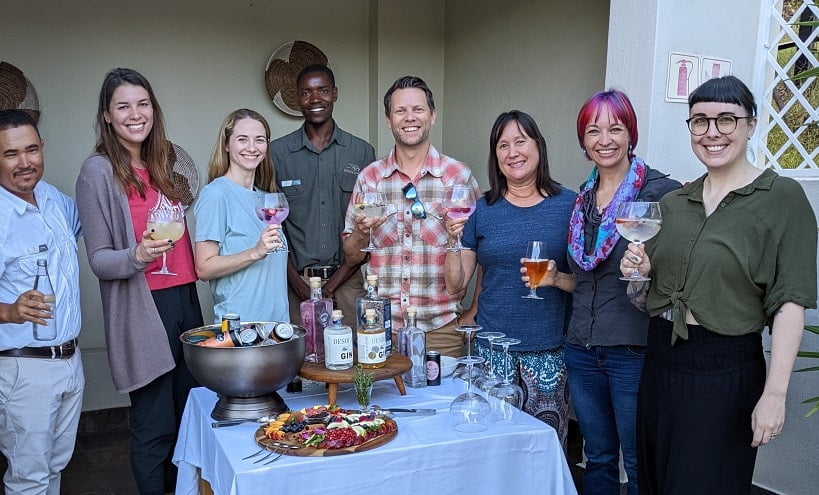
The next day we headed off on our driving adventure (which is a great way to travel in Namibia and leaves the day ripe for unexpected experiences) in one of Ultimate’s custom designed Land Cruisers. Johann Cloete, one of Ultimate’s senior guides, was our fearless leader. He’s a well-known Ultimate guide and has decades of experience as both a private guide as well as a camp-based guide, including years spent at Desert Rhino Camp, where I first met him on another Ultimate FAM back in 2015! He has a wealth of experience and knowledge in Namibian tourism – particularly in Damaraland where desert-adapted rhino and elephant tracking is a highlight.
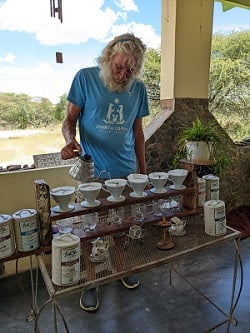 We were headed to Sossusvlei (approx. 5-6 hour drive on good roads, tar and well-graded gravel, like many in Namibia), and en route we were treated to a unique, unexpected experience – a stop at Conny’s Coffee. Run by a very eccentric, very cool Namibian-German named Gunter who was a true coffee savant – this is a memorable stop in a remote settlement and a total surprise. Gunter took us through a pour over coffee tasting of different types of African coffee (from Kenya, Uganda, Ethiopia, and Rwanda) while providing context around each brew. We all enjoyed the great tasting while learning about Gunther’s life in this rural area. We followed up our tasting with one of Ultimate’s famous magic box picnics to fortify us for the rest of the journey.
We were headed to Sossusvlei (approx. 5-6 hour drive on good roads, tar and well-graded gravel, like many in Namibia), and en route we were treated to a unique, unexpected experience – a stop at Conny’s Coffee. Run by a very eccentric, very cool Namibian-German named Gunter who was a true coffee savant – this is a memorable stop in a remote settlement and a total surprise. Gunter took us through a pour over coffee tasting of different types of African coffee (from Kenya, Uganda, Ethiopia, and Rwanda) while providing context around each brew. We all enjoyed the great tasting while learning about Gunther’s life in this rural area. We followed up our tasting with one of Ultimate’s famous magic box picnics to fortify us for the rest of the journey.
What I love about Ultimate’s picnics is that they are anything but the typical sad boxed lunches. No soggy sandwich with chips, peanuts and a decent cookie if you’re lucky. Ultimate’s magic box picnics are far more filling and delicious with creative wraps, beautiful salads, fresh fruit and more. It’s a much more refined picnic than most people expect or would typically be found on safari.
We arrived at Ultimate’s Camp Sossus on the Namib Tsaris Conservancy, just 30 minutes from Sossusvlei’s Sesreim gate, in the late afternoon. Good news – previously, the camp was exclusive-use only but as of April 2022, it is open to individual bookings as well. I visited in 2018 when it had just opened for exclusive use and loved the intimate, 8-tent camp. Typically, only 6 tents are in use with the remaining two used for guides.
I think that the most special thing about Camp Sossus is that you have a 40,000-acre private conservancy shared among a maximum of 12 guests. There is good game – from oryx to mountain zebra, giraffe, bat eared foxes, jackals and even leopards (though the latter are not often seen). The camp is well off the road to Sesreim, so when you’re there all you see is the beautiful desert and at night the darkness is complete with brilliant night skies.
Each of the tents at Camp Sossus has everything you need but nothing you don’t – it’s barefoot luxury in the Namibian desert. There are flush loos and running water but also the novel luxury of a bucket shower which everyone should enjoy at least once while on safari! Since my visit in 2018, they’ve added star beds on top of the tents, which are absolutely amazing. The bathrooms used to be open air, so adding the star beds over the structure helped as a windbreak and added a bathroom roof – innovative! It’s easy to come down from the Star bed via the stairway if you change your mind and want to sleep inside.
I enjoyed sleeping out both nights as Sossusvlei (and Namibia in general) has some of the best dark skies on earth (the conservancy is located next to a well-known International Dark Sky Reserve, the Namib Rand). My first night under the stars had a nearly full moon, which doesn’t make for the best stargazing, but sleeping under the moonlight in the dry desert is a delightful experience that I highly recommend.
Beyond having the reserve to yourself, another thing that makes Camp Sossus special is the incredible staff and amazing food. What they can produce out of a mobile tented camp kitchen is extraordinary! I highly recommend interested guests request to tour the kitchen – they will be blown away with what they prepare with the seemingly limited resources they have.
After arriving, we went for a walk to a stunning sundowner spot and if you’ve never had sundowners in Namibia, let me just say that it’s one of the best, most beautiful countries for sundowners in the whole of Africa. Of course, it doesn’t hurt that Ultimate goes above and beyond for their sundowners with special touches like comfy couches (out in the desert!) and a range of boutique gins and delicious snacks. Watching the sun set over the dunes is something none of us will ever forget.
About those delicious snacks – every morsel of food I ate at Camp Sossus was incredible! Everything was delectable, super fresh (oh that bread!) and creative. Ultimate has raised the bar for safari cuisine in Namibia!!
We started the next morning with oatmeal with Jameson and honey (yes – whiskey oats!), along with strong coffee to fuel our Sossusvlei adventures. It’s just 30 minutes from Camp Sossus to the gate, but it still requires an early start as you need to be there when it opens, which in our case was at 6am (Note that the timing is seasonal depending on the time of the sunrise). It’s an early day but totally worth it to get there to maximize photo experiences and activities – and to avoid the heat of the day.
A quick side note for photography guests/groups – there are two opportunities/accommodations to stay inside the park – Sossus Dune Lodge and Dead Valley Lodge. Choosing to stay inside the park allows keen photographers to get to the dunes prior to sunrise to be there for daybreak, as well as to spend time in the park at sunset.
We snapped lots of photos as we drove through the park, arriving at Big Daddy (Sossusvlei’s highest dune) about 30 minutes from the time we entered the gate. I have been lucky to visit Sossusvlei several times but have never had the chance to climb Big Daddy and I was excited when our group decided to go for it! As we left the car to walk to the start of the climb, we encountered an extremely rare sight – a pan of water in front of Big Daddy! To illustrate how special this was – it was the first time our guide Johann had ever seen this pan with water in it! It was a special moment to see dunes reflected in water – something quite historic.
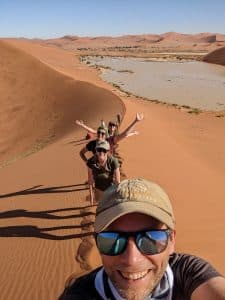 The hike up Big Daddy is long and hard. Hiking in sand is a ‘one step forward, two steps back’ endeavor. Add to that the sheer size of the dune and you’re in for a fitness test. It takes about an hour and a half to get up. We started with the full group but only two finished (you can bail out and run down to Deadvlei from most anywhere). The views while climbing are awesome and rewarding – especially from the summit! There is an awesome view of Deadvlei from the highest point, you can see White Mountain and get 360-degree views of the sand sea – it’s well worth the effort! THEN you get to run straight down to Deadvlei (maybe a 5-minute run down the dune which is wildly fun). There’s a bit of a pause as you empty your shoes of copious quantities of sand when you make it down before walking on through the pan at Deadvlei. Summiting Big Daddy has that same awesome feeling of hitting the top of any iconic peak – it’s awesome!
The hike up Big Daddy is long and hard. Hiking in sand is a ‘one step forward, two steps back’ endeavor. Add to that the sheer size of the dune and you’re in for a fitness test. It takes about an hour and a half to get up. We started with the full group but only two finished (you can bail out and run down to Deadvlei from most anywhere). The views while climbing are awesome and rewarding – especially from the summit! There is an awesome view of Deadvlei from the highest point, you can see White Mountain and get 360-degree views of the sand sea – it’s well worth the effort! THEN you get to run straight down to Deadvlei (maybe a 5-minute run down the dune which is wildly fun). There’s a bit of a pause as you empty your shoes of copious quantities of sand when you make it down before walking on through the pan at Deadvlei. Summiting Big Daddy has that same awesome feeling of hitting the top of any iconic peak – it’s awesome!
Moving on to Deadvlei – it is an extraordinary photography experience to capture the ancient trees that have been preserved by the desert. You can feel its ancient history and marvel at its beautiful desolation.
After a very active morning we were all ready for our second magic box picnic brunch, this one complete with champagne and mimosas(!), which we enjoyed near the shadow of Big Mamma and Sossusvlei Pan. We toasted our time in Sossusvlei and filled our bellies with a delicious meal. You can expect that every Ultimate Safari trip will have a great brunch after their Sossusvlei exploration.
The Namib Tsaris Conservancy was once a sheep ranch (as many reserves were) that was then converted into a wildlife reserve. On the reserve there are old water tanks that Ultimate have repurposed by converting them into swimming pools and sundowner spots. On the way back to camp, we detoured to take in the view from one of the tanks, which turned out to be one of these surprise spots! As guests climb to the top for the view the surprise is revealed. It’s a super fun surprise to then enjoy delicious ice cream with an amazing view – so great after a long day of being hot and sweaty. I can’t think of anything more refreshing – it makes for a great surprise and delight moment! For guests staying longer a dip in the pool is also pretty great.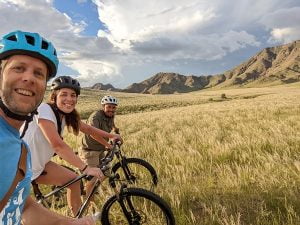
We returned to Camp Sossus and were still keen to be active, so a couple of us went off on the optional mountain biking activity. Ultimate has great mountain bikes – they are well maintained and well suited to the terrain. There are paths and the roads are great for biking as well. As we pedaled along, we spotted oryx and zebra. It was a great feeling being out on the reserve – it truly feels like a private playground. It was particularly special as the plains were in bloom with silver sage grass, along with pink and yellow flowers from the rains. It was a super special treat to see the desert in bloom with the incredible contrast in colors and terrain. We followed our ride with a refreshing G+T back in camp.
Guests staying 3 nights have the chance to go up to the top of the escarpment. It’s a whole different area with different game, including giraffe and mountain zebra. They can enjoy a Champagne brunch up top, more diverse terrain for biking, the chance to take a dip in one of the water tank pools, and more. It’s great to explore in various ways – vehicle, foot, mountain bike – but it really requires a third night.
Namib Tsaris also offers the accommodation option of The Nest, a unique private home designed in the style of a social weaver’s nest. The award-winning home is located on the opposite side of the reserve from Camp Sossus and sleeps up to 7 in a super exclusive architectural wonder. The Nest has a private pool and playground, and Ultimate will bring in their staff and chef (even one with a Michelin star as an option) to pamper your clients. It’s excellent for families and groups, or a client looking for the ultimate in privacy and exclusivity.
From Camp Sossus, we were off to Swakopmund. Situated by the sea, it is typically something of an afterthought or mere stopover on a Namibian safari. Swakopmund, or ‘Swakop’ as it’s affectionately known, is a very cool spot to spend a few nights. Often on a driving safari it’s a stop that breaks up longer drives (such as the Ultimate Namibia set departure and it serves that purpose well. It does so by changing up the landscapes and experiences from sand and the dry desert to a cool, misty ocean setting, letting guests shake off the dust and enjoy the smell and feel of the ocean. It also guarantees a few nights of good, fast Wi-Fi, which is so in demand these days. Swakop is an interesting and totally unique place – a German/Bavarian village randomly situated on a remote stretch of coast in Africa.
Another pitch in favor of a few days in Swakopmund is that it breaks up what is most often meat heavy cuisine on a Namibian safari (though of course Ultimate caters – and very well, I might add – to any dietary restrictions) with fantastic seafood (oysters!).
Beyond helping to break up a driving safari, Swakop holds a lot of interest. When I went with my family years ago, we did a living desert tour. I didn’t have high expectations – having experienced the dunes at Sossusvlei, I didn’t think there was any way the dunes near Swakopmund could compare, but I was pleasantly surprised. The coastal dunes are more yellowish and lighter burnt orange and are rather more substantial than I had expected. The living desert tour ended up being a fascinating deep dive into desert life which I think is especially fun for kids. My daughter was 4 at the time (she celebrated her 4th birthday in Swakop), and the chance to find and learn about insects and reptiles was a super fun experience for her (and us!).
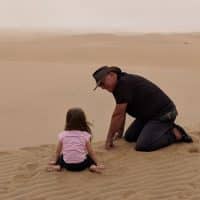
We found everything from skinks to snakes, spiders and geckos, and learning more about how the reptiles adapt to living in the desert was fascinating. Beyond that, the guides are excellent at tailoring the experience for kids. The experience is very accessible for kids as you can get so close to (and sometimes even hold when appropriate) the ‘safe’ wildlife. My daughter was enthralled holding a skink, we got to take up close photos of a gecko and learned about how the different minerals influence the color of the sand. Her mind was blown when the guide brought out a magnet to show her how much iron was in the sand – the magnet pulled the iron out of the sand that was on her arm.
After the tour we did a Land Cruiser drive through the dunes, which was really fun! We also had the chance to climb the dunes, which are far more accessible than dunes like Big Daddy. The desert around Swakopmund is great for families.

Another excellent option in Swakop is to get into the bay. Kayaking is a top choice, with the chance to see seals, dolphins and whales if you’re lucky, or for a less physical exploration option, I’d suggest a catamaran tour. With Ultimate, exploring the bay ends with a Champagne oyster brunch on the beach. Would you expect anything less?
Swakopmund has a really good range of accommodations. One notable property is The Delight and I stayed there on my last visit with my family – pardon the pun but it really was delightful. It has great rooms for families. The Delight is located a little outside the city center but is easily walkable.
Recent years have seen the redevelopment of the Strand complex, which has wonderfully resulted in some great new restaurants. Included among them are Butcher & Brewer, a sports/beer bar right on the water and Ocean Cellar, a fantastic seafood spot. The Strand is the best upmarket option right on the water and has great views of the harbor. During my stay I was lucky to be gazing at the beautiful view from my balcony when I spotted some dolphins playing in the waves in the harbor!
The town itself is an attraction in the sense that It transports you to Germany/Bavaria for a day or two during your stay. And it’s not just the architecture! You can enjoy excellent bratwurst and schnitzel in local restaurants – some of the best I have ever had was in Swakop – and you can also sample fantastic German style pilsners and lagers.
Another experience that Ultimate includes for their guides on safari with your clients is having dinner together at the iconic Tug restaurant. The Tug is a very well-known seafood restaurant next to the pier right above the water. It sometimes feels like the ocean’s waves are breaking on the restaurant! It’s definitely touristy, but there’s a reason for that – it always delivers an amazing seafood meal. Our FAM group raved for days about the meal we had there.
Swakopmund is a lovely and unexpected break from safari which I think sometimes is well needed – especially on a driving safari. A simple parallel would be spending time in Cape Town while on safari in South Africa. The weather can be quite cool, misty and cloudy like the Pacific coast of the US, but it can also deliver bright, sunny days for a beachy feel. Either way, it’s a nice change of pace from safari and the rest of Namibia (or Africa, for that matter!). It’s well worth spending 2 nights in town, and with kids I’d consider 3 nights so that you can enjoy the dunes, time in town and a cruise.
From Swakopmund, we ventured up far into the Skeleton Coast to Shipwreck Lodge. Shipwreck is the only lodge truly located on the famed Skeleton Coast – and the entire coast of the country. The entire coastline of the country is protected in the constitution, making for very little coastal development. Most people fly into Mowe Bay, from where it is about 1.5-2 hours’ drive along the coastal dunes to the Lodge. We drove – definitely a more adventurous (and cost conscious) move – giving us the chance to traverse a lot more of the Skeleton Coast, something very few travelers do.
The drive from Swakop gives you the chance to see the most accessible and most complete shipwrecks that can be viewed from the beach, including the Zelia, a wreck from 2008. One important note about the Skeleton Coast – everyone asks about seeing the famous shipwrecks while on the coast, but the secret is that most of them are most easily and best seen from the air on a scenic flight. Most are too hard to reach or are totally unreachable. Remember that flights are weather dependent, so if this is something important to your clients, let Ultimate know so they can set them up for the best chance to get up in the air to see them.
We were in for a full day’s drive to reach Shipwreck Lodge. We weren’t certain we were going to make it because of recent rains. Ephemeral rivers were flowing and, in some cases, flooding through to the ocean. The //Huab and Hoanib rivers were spurring concerning reports from Ultimate staff as well as from the staff at Shipwreck Lodge. We headed off with the hope that we would make it, deciding it was worth the risk and adventure. Our ‘plan B’ would be staying at the Namibia Wildlife Resort in Terrace Bay where we could at least get a cold beer and count on a view of the ocean.
After a few hours we had a photogenic stop at the Zelia, languishing in the surf. Looking out at the barren desert and the gravel plains to the east and the wild raging surf to the west, we knew the rest of our drive would be an adventure into the unknown. We spotted occasional wildlife including a jackal who had been scavenging overnight and an oryx in the distance. But a drive like this is really a time to relax, contemplate life, listen to a podcast, or meditate on the raw scenery.
We were lucky and had a good weather window as it was not too windy. Because of the uncertainty of the road ahead we decided to eat in the car to save time. Typically, if the river crossings aren’t a concern, we would do a magic box picnic on the windswept coast to take it all in. We would set up somewhere along the beach in good weather or in a more sheltered place if the weather is bad.
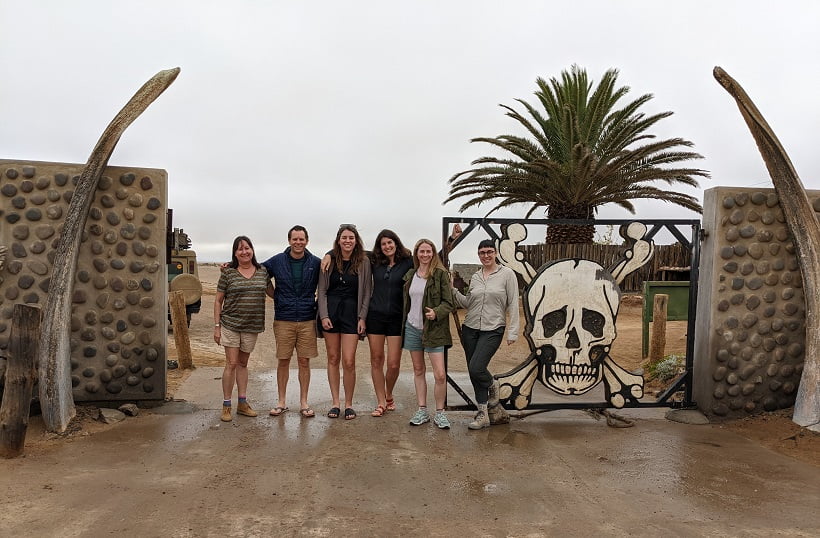
Entry into the park from Swakopmund is through the Ugab gate, an iconic photo spot with the famous skull and crossbones and whale bones where you enter the Skeleton Coast National Park. It’s at the end of the salt road, which is just another of the cool things about Namibia – driving along incredibly good salt roads. They are created by pumping salt water, letting the water evaporate and the salt settle to create a road. These are the most comfortable, smooth roads in Namibia and maybe even the world – they are smoother than gravel and tarmac both! About half of the drive to the Lodge is on salt roads and from there on out it’s dirt.
Shortly after we passed through the gate, we crossed the //Huab river, which was still flowing but thankfully not impassible. The Hoanib would be the last river we would have to be concerned about. In the days leading up to our journey the road across the Hoanib had almost been washed out, but luckily there was still enough road left for us to cross the river. Johann piloted us across with no issues, which was a mix between a relief and let down as we were primed for a bit of a challenging adventure. Once we crossed the Hoanib, our Ultimate vehicles are parked and left behind as it is the pickup point for Shipwreck Lodge.
From this spot (Mowe Bay) there is a seal colony to entertain you if you must wait. It’s also where Dr. Flip Stander, a legend in desert lion research, has his house. If you’re lucky, you might run into him if he’s not in the field tracking desert-adapted lions. It’s about 8 hours from Swakop. Making this drive really gives a handle on understanding how remote Shipwreck Lodge and Mowe Bay is, something that’s lost when flying. The rest of the journey to the lodge is all on the coastal dunes.
Departing from Mowe Bay feels so isolated you almost expect that there isn’t really a lodge anywhere nearby. Shipwreck is a funky, unique looking lodge inspired by the shipwrecks that litter the coast. This is a place for people that want to truly escape and really unplug with nothing but raw wilderness (though it’s also very comfortable). The main lodge has nautical themes and touches, making guests feel connected to the ocean and seafaring. There are large seating areas with huge windows offering views of dunes and the coast – the lodge is about ½ mile from the ocean, which you can see and hear from the lodge.
Shipwreck has 10 rooms – 5 on each side – connected by boardwalks. All have a nautical feel. The weather was warm and sunny (and by that, I mean unseasonable) during our visit, so we didn’t really get how cozy and warm the cabins would be in more typical weather. There are nice wood stoves in each, which would be wonderful on a typical misty or stormy night but would have been more like a sauna during our visit!
The main draw to Shipwreck is finding yourself in a luxurious, comfortable lodge on the remote edge of the earth. Activities include sundowners, heading inland to visit unique geological formations, tracking desert-adapted lions and elephants, beach picnics and walks. Everything is totally weather dependent – as an example, we couldn’t go inland as the route was impassable because of recent rains.
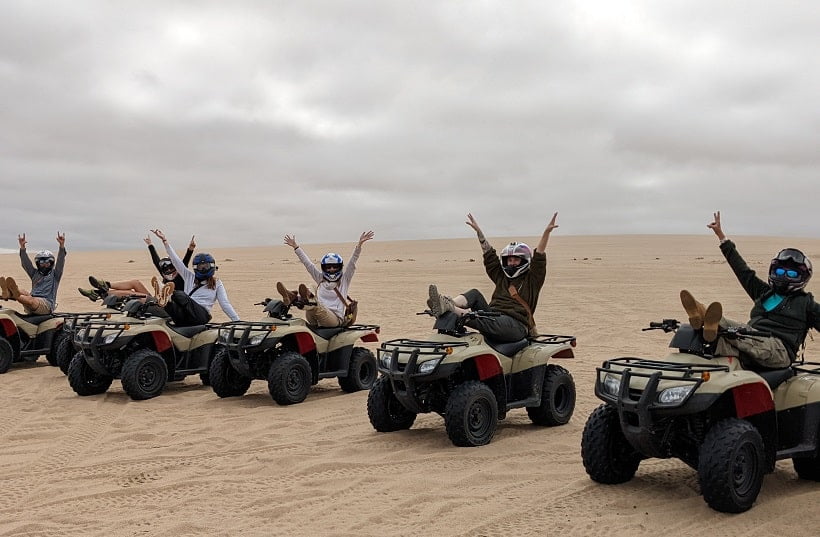
On our second day, we enjoyed a leisurely walk to the beach and settled on a bluff for a lovely lunch right above the ocean with the waves crashing below us. Then we headed out on ATV’s, which I expected to hate but ended up loving. It’s loud, gasoline-based and seems a little antithetical to the location but ultimately it was super fun, and everyone had a great time exploring the dunes. Thankfully quad biking is only allowed in a small section of the dunes to preserve the pristine environment. We even found relatively fresh lion tracks on our ride! After that we went sandboarding – another super fun activity where we spent an hour racing down the dunes on a sandboard.
Another highlight of our stay was a sundowner on the beach. Walking barefoot at the edge of the Atlantic to explore tide pools, skip rocks…having the chance to spend idle time with our feet in the water and in the sand as the sun was setting was truly unique for an African safari. You might get that in South Africa or Mozambique, but those are more tropical settings. It’s a totally different feel on a wild, untamed coast.
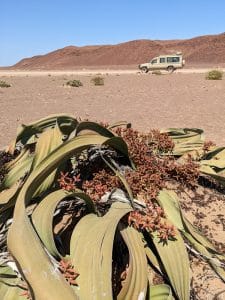
Welwitschia are ‘living fossils’
After two nights at Shipwreck Lodge, we headed back south along the coast and out of the park, moving inland toward Damaraland via the Springbok Gate. Along the way we came across welwitschia, an ancient plant only found in Namibia and Angola in the Kaokoveld Desert that is also known as a ‘living fossil,’ due to its longevity – they are thought to live up to (at least) an astonishing 2,000 years in this desert environment. This area of gravel plains heading towards Brandberg Mountain is a good place to see these unusual plants, and to stop for a stretch to learn about them.
After our stop, we continued to Onduli Ridge. What you figure out pretty quickly is that you are quite close to one of the “busy” parts of Damaraland (this is Namibia, so that’s very relative) – Twefylfontein – which is a UNESCO World Heritage Site, but when you’re at Onduli you feel like you’re completely removed from the hustle and bustle of this heart of Damaraland. The camp is located over a ridge and when you’re there you’re away from it all. It’s a very exclusive and remote-feeling area.
We were very lucky to spend two nights and one full day at Onduli Ridge. It’s a place where you want to spend time at the lodge to experience what it has to offer. It has six villas tucked into granite boulders that are saddled between two kopjes. The idea for Onduli blossomed when Tristan and his family drive around Doro !Nawas looking for a location. Onduli’s location stood out, as if was meant to have a lodge on it. The way Ultimate nestled the villas and pool between two boulders that create an archway is incredible – it’s literally the perfect spot. It was designed to maximize privacy of each room as well as space and views. My first and enduring thought about the villas is to wonder at how you can be in the room and feel that it’s so spacious because of the way it opens up to the deck and totally unobstructed views. You never feel like you’re near any neighbors. Also, with only six rooms it feels very exclusive.
The villa’s bathrooms give you the feel of being nestled amongst the boulders. They are open air but covered – the surrounding geology is elemental in the design. Each bedroom area has cantilevered shutters that can be closed up completely for those who want more privacy or don’t want to sleep in the open air (or left open for those who prefer). The coolest feature is that the bed can be taken out onto the very large verandah for a star bed experience. All of our group opted to sleep outside both nights. It’s extraordinary to be out under Namibia’s massive skies, hearing hyenas calling and jackals yipping. Being immersed in the night sounds of the bush is a very special experience.
Our first evening we enjoyed sundowners on the deck while soaking up the views. We were treated to an awesome display of sabrage skill, as our camp host treated us to what must be a unique flourish of sparkling wine opening in the whole of Namibia. Ultimate will include this fun surprise for your guests at Onduli one night during their stay. It was a totally unexpected and cool touch! It was certainly a sundowner ‘first’ for me!
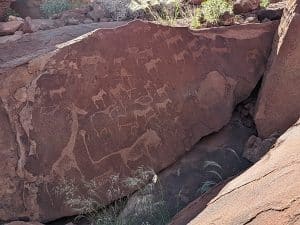 On our one full day in the Damaraland area, we had a lot to accomplish and weren’t sure we could manage it all. Of course we had to see Twefylfontein, so we set off right after breakfast. Lucky for us it was not at all busy. This was my second visit and I was reminded of the fascinating history of the site. It is always amazing to see the incredible rock art paintings done between 2-5000 years ago by the San who originally inhabited the area. It is encouraging to see how well preserved they are – even before UNESCO protection, the paintings were never vandalized or ruined in any way. The desert has helped in their preservation. It is wild to see different animals and spiritual practices as well as to see coastal animals depicted on the rocks. The San were clearly exploring the area and very mobile – it is around 100 miles to the coast!
On our one full day in the Damaraland area, we had a lot to accomplish and weren’t sure we could manage it all. Of course we had to see Twefylfontein, so we set off right after breakfast. Lucky for us it was not at all busy. This was my second visit and I was reminded of the fascinating history of the site. It is always amazing to see the incredible rock art paintings done between 2-5000 years ago by the San who originally inhabited the area. It is encouraging to see how well preserved they are – even before UNESCO protection, the paintings were never vandalized or ruined in any way. The desert has helped in their preservation. It is wild to see different animals and spiritual practices as well as to see coastal animals depicted on the rocks. The San were clearly exploring the area and very mobile – it is around 100 miles to the coast!
From Twefylfontein, we went in search of desert-adapted elephants but based on recent rains, Johann knew that most elephants would have headed up to the mountains. But luck was with us – we immediately came across fresh tracks, and the twinkle in Johann’s eyes let us know we had a chance! We had a limited time as we were on ‘FAM time’ – we were restrained by the need to get back to the lodge for lunch, for afternoon activities and for the chance to enjoy the camp – so we all hoped for quick success in finding the elephants.
Tracking desert-adapted wildlife is an awesome experience. It’s different from a regular safari – your expert guide has to look carefully for tiny signs of wildlife in the landscape or find and follow tracks. In this case, it was evident that the branches were freshly torn (a few hours at most). We followed the tracks and broken vegetation and within 10 minutes we spotted a herd of about twelve elephants and then spent a blissful hour with them as they crossed open plains into an ephemeral river where they were feeding. It was amazing to see these animals, who survive in seemingly insane conditions, in an atypical sighting. Because of the recent rains, the plains were dotted with yellow, purple and pink flowers with ochre hills in the background. We felt very lucky!
There are between 300 and 400 desert-adapted elephants located in Namibia. When you stop to think about that number and the enormity of the territory they cover, to find and then spend an hour with them was a huge privilege.
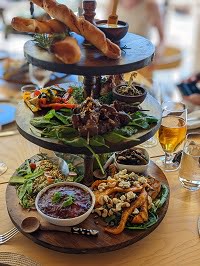 We got back to the lodge to experience the lunch tasting menu. What I have found with Ultimate Safaris and particularly Onduli – nothing is opulent or over the top – the magic is that everything is so thoughtfully and uniquely presented. It is refined, yet accessible. Service from the team is so genuine and subtle that you almost don’t notice how great it is. They seem to anticipate what you need before you even know it. The tasting menu was like a mezze platter on three different tiers with a wide variety of dishes ranging from roasted butternut with seeds and nuts to flavorful meat skewers and a light noodle salad. Everything was super fresh, delicious and the entire meal was amazing.
We got back to the lodge to experience the lunch tasting menu. What I have found with Ultimate Safaris and particularly Onduli – nothing is opulent or over the top – the magic is that everything is so thoughtfully and uniquely presented. It is refined, yet accessible. Service from the team is so genuine and subtle that you almost don’t notice how great it is. They seem to anticipate what you need before you even know it. The tasting menu was like a mezze platter on three different tiers with a wide variety of dishes ranging from roasted butternut with seeds and nuts to flavorful meat skewers and a light noodle salad. Everything was super fresh, delicious and the entire meal was amazing.
After our feast, we were in for a full afternoon. Several of us chose to explore the Doro !Nawas conservancy by mountain bike. Onduli has ebikes and there are planned trails that have been architected which makes it extra fun. The e-assist doesn’t hurt either! We biked, explored, climbed kopjes, and even stopped for a ‘roadie’ beer midway through the ride. After our cycle, we headed back to cool off in the pool. Ebike rides at Onduli can be as little as 30 minutes of assisted pedaling, or if you’re looking for real exercise there are longer trails and lots of terrain to explore.
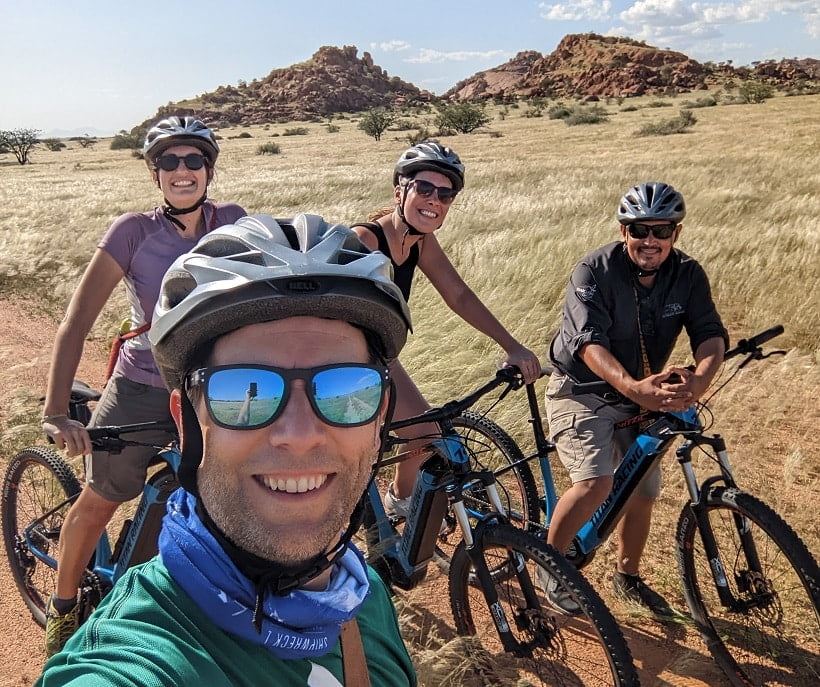
We were lucky to also experience another Onduli signature activity – a cellar wine tasting. One of the team at Onduli is a self-taught oenophile and does a super fun tasting for guests. Typically, with a group they turn the tasting into a competition to add to the fun. We tasted three whites and three reds and wrote down the flavor profiles of the wines we were tasting. The person most accurate in their descriptions is then declared the ‘winner,’ going home with a vial of the prised Onduli commiphora-infused artisan (cooking/finishing) salt. We sampled several delicious infused salts during the lunch tasting menu (w/ bread and olive oil). We raved about them at lunch and then the winner got some to take home!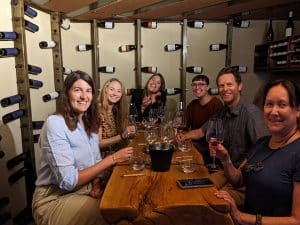
Somehow, I managed to identify four out of six flavors and was declared the winner. The ‘contest’ is another fine example of a unique experience at Onduli. Having a cellar tasting might be something you’d expect at a top end lodge, but certainly no other place in Namibia. While Onduli isn’t the most luxe lodge in the country, the experience is truly top tier.
Following the tasting we had pizza night. Onduli has an outdoor pizza oven, and while that may not be unique in Africa, it is unique in Namibia. It makes for a different and super fun dinner, especially choosing your own toppings to design your own meal. One of our FAM guests, who happened to be Italian, taught the staff how to make bruschetta – real Italian bruschetta! As a result, we added a bit more Italian flair to the evening. Hopefully it will be offered to future guests in addition to the delicious pizza we enjoyed around the boma campfire.
Many of these creative culinary experiences were crafted by Onduli’s fantastic staff. Our wine experience was something pitched to Tristan by the creative Onduli Ridge staff. Rhona, a cuisine consultant who is helping to elevate Ultimate’s cuisine at their camps, created the infused salts.
The team at Onduli anticipates what you need before you need it. As an example, the last morning I came to the main lodge with coffee I made in my room and had nearly finished. I set it down on the breakfast table and someone handed me a fresh coffee the moment I was done. All of the service at Onduli is like this – it’s another part of what makes a stay so special.
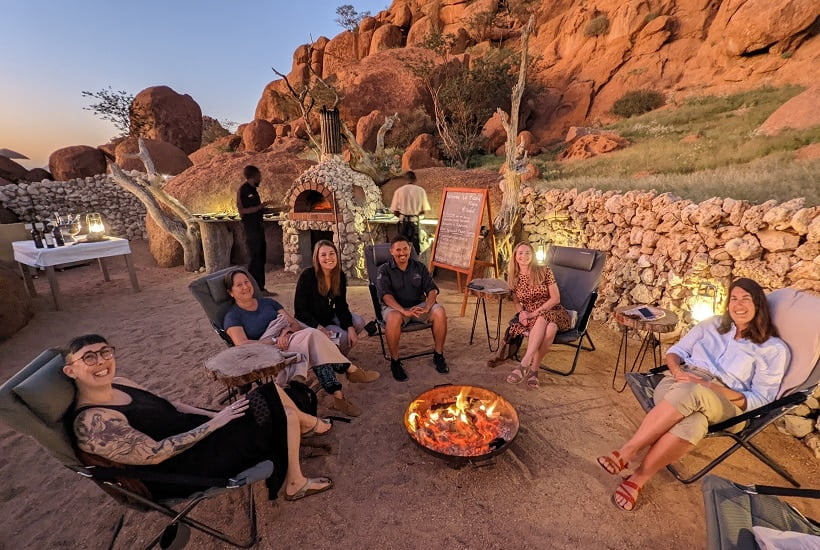
Onduli is an incredible lodge where you could easily spend a week – it would still go by too quickly! It’s a true home away from home. When you’re there, you don’t want to leave the lodge, but when you do, you’re within half an hour of Twefylfontein, more incredible desert geology, landscapes where you can search for desert-adapted wildlife and more. There is so much to do, three nights isn’t nearly enough. Ultimate has really created something special – we all felt it during our stay as has every lucky guest.
We spent our last night at Zanier Omaanda, which is located outside Windhoek, just 30 minutes from the airport. It’s a great option for one or two nights at the start or end of a Namibia safari. We thought Omaanda was the perfect spot to relax after a busy safari – enjoy the delicious cuisine, have a spa treatment or two, swim in the pool and generally just slow down. They do offer game drives and there is actually decent game but it’s not the focus and definitely not for safari purists (from certain vantage points, you can see the Windhoek airport and occasionally hear and see planes taking off). My advice, sell the food, spa and lovely rooms, and easy access to the airport. (Another option near the airport which offers a similar experience is Habitats Namibia, which also offers a focus on yoga, meditation and spiritual practice.
Namibia and Ultimate Safaris once again delivered an exceptional and unique safari experience. Ultimate’s camps are going from strength to strength. As always, their guide team is legendary and Johann lived up to that very high standard and more. The diverse and otherworldly landscapes were equally spectacular and peaceful, the little surprises, the desert adapted game and one of the best FAM groups ever, made for an incredible trip!
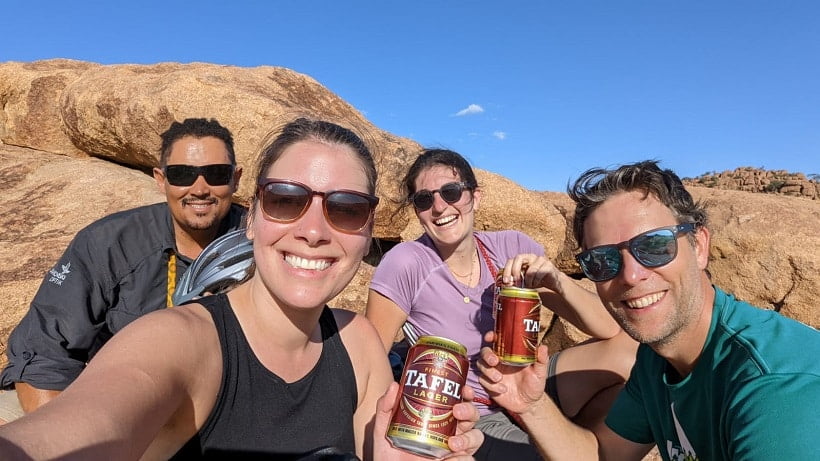
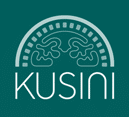


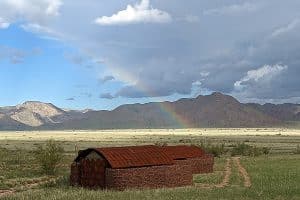
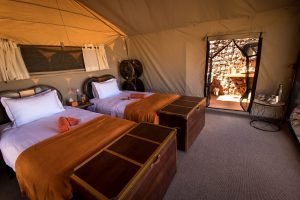
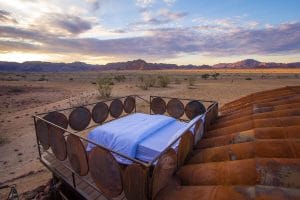
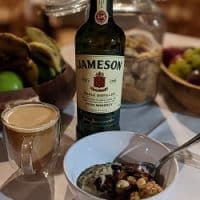
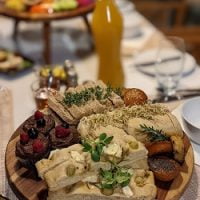
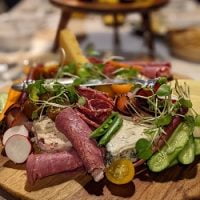
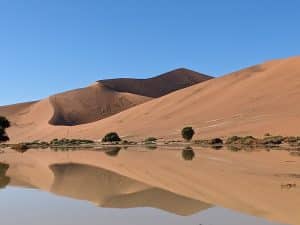
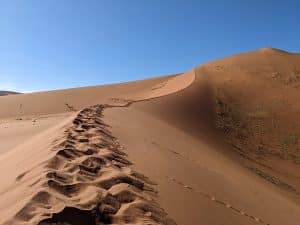
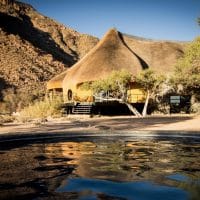
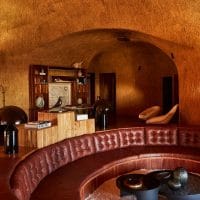
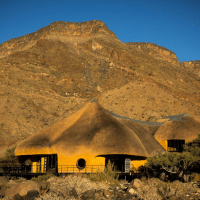
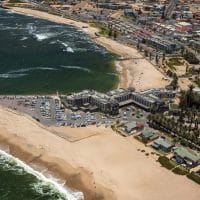
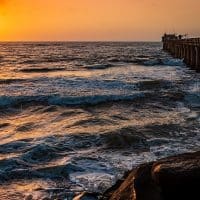
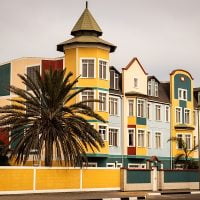
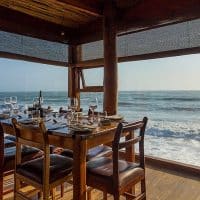
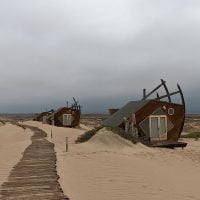
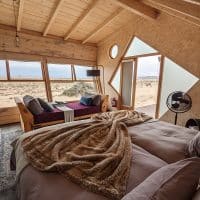
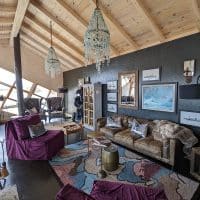
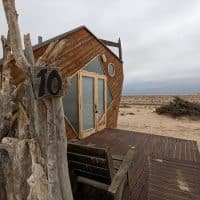
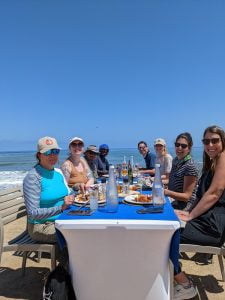
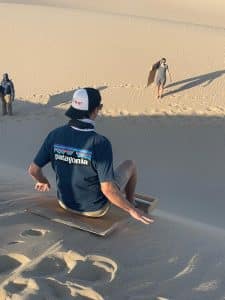
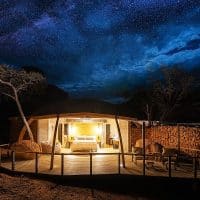
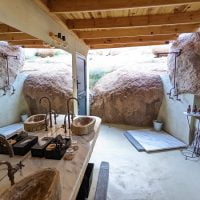
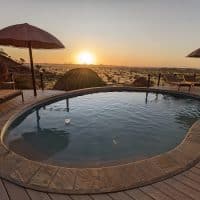
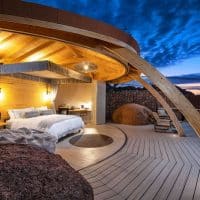
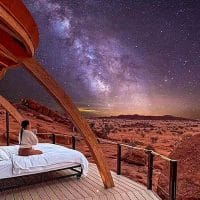
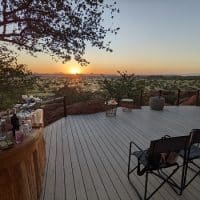
Leave A Comment
You must be logged in to post a comment.